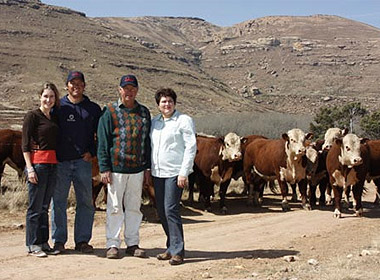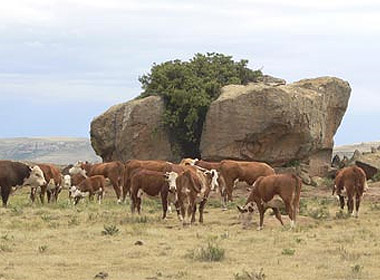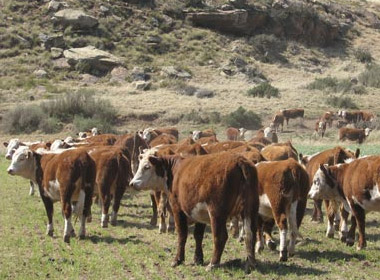The KRM Hereford herd came into being in 1972 when my father the late Calvert Clark decided that the progress made with regard to veld improvement running sheep only was too slow. The switch to more cattle resulted in the first registered females being purchased from various Eastern Cape breeders with the majority of cows coming from the Lambra stud which were purchased on a dispersal sale in Burgersdorp.
These females were medium framed, rangy cows, which had escaped the fashionable small-framed dumpy type bred in the late fifty’s, and sixties. Later in 1982 a number of females were purchased from the MV Stud in Mooi River.
In the summer of 1983 first calf heifers were mated from both the 15 and 27 month old heifers groups with a view to increasing cow numbers dramatically. This was achieved by ensuring that the yearling heifers weighed 325kg at mating time mainly by way of strip grazing on annual ryegrass for a few hours each day instead of being wintered the conventional way on a lick. These young cows were also kept separate at calving time and given better treatment than the rest of the cow herd. This proved to be very successful despite having strictly adhered to the policy of culling all open females at weaning time.
One of the females born during this period was none other than KRM Music T46 who was born in 1985 and had her first calf at the age of 24 months. Music T46 was the dam of KRM Apex A12, her third calf who in turn was the first homebred bull to have been retained for use in the KRM herd. Apex then became a Taurus AI bull and in 1992 recorded the second highest semen sales for all beef breeds that year. Apex then bred KRM Dollar D13 who in turn bred KRM Plymouth 1-022. Apex still has top females at work in the breed both in our herd and in the herds of fellow breeders. Music T46 then went on to breed KRM Carbon Copy C40 who in turn bred KRM Jamba J22, a bull which was used in a number of herds.
Another stud bull bred from T46 was KRM Geronimo G38 who bred Douvat Ludwig for Mr Gerrit Kruger of Steynsburg and semen from this bull was sold to many breeders across the country. Music T46 stayed in the herd until the age of 15 years, having weaned 14 natural calves with an average ICP of 367 days. This T46 achieved despite having been flushed for embryos on three different occasions and each time she conceived immediately by natural service. Music T46 had the further distinction of being named Reserve Grand Champion Hereford Female as well as Super Cow at the 1999 Hereford Nationals at the age of 14 years.



When the drought years struck in 1991 and with adequate cow numbers we decided to cut input costs and revert back to mating at 27 months. Since the 1991 drought we had a severe drought every four years viz. 1995,1999,2003 – and the droughts were worse each time, but each time one learnt some new survival skills and somehow the cattle managed to cope each time. One thing than does not improve, however, is the anxiety of worrying when it will rain again. In the meantime importing semen from the U.S.A and Canada was the in thing and initially the bulls imported did well to improve the carcass traits and by making the local Hereford slightly later maturing the cattle were more acceptable to market requirements as excessive fat deposits on a carcass were not acceptable to the market anymore. Here I think of bulls such as Klondike Banner 469L, GK Justification and BT Butler 452M and later Star Donald 335F.
Then breeders overreacted worldwide and went too late maturing and all of a sudden we realized that as the cattle became taller and faster growing they lost their thickness, finishing ability, toughness and fertility. Fortunately we could compare the ultra modern late maturing cattle with the more medium framed cattle and draw our own conclusions.
Results achieved with our own sires as well as those used from Mr. Dave Worrall’s MV Stud put us in a position to make good progress with bulls that were adapted to local conditions. After a trip to Australia and New Zealand in 1998 semen from three bulls from “Down Under” were used and so we eventually had the opportunity to compare our own bulls with some foreign blood bred off grass. Needless to say I have since realized after a second visit to Australia to attend the World Hereford Conference in 2004 that conditions in most of Southern Africa are unique in the cattle world because our natural pasture is either sour or matures quickly with the result that our cattle need to have a better constitution with less growth than is the case in the rest of the world.
In 1995 South African Hereford breeders gained access to ebv’s for the first time and were in the fortunate position that this breeding aid was not a new concept as these figures had been available on AI sires from North American for some time even though in the form of epd’s. The experience of having studied the epd’s of these sires clearly highlighted the negative correlation’s which existed between the various production traits. These observations illustrated clearly that very growthy bulls with extreme ebv’s we not suited to South African conditions and that BLUP ebv’s were only a tool, which had to be managed correctly in order to serve a useful purpose.
Breeding values (ebv’s) are however the most accurate tool available to breed cattle which are better suited to a particular production system. The user must be able to make an accurate estimation of the optimum level of animal performance (milk production, growth and mature size) for a particular environment or production system also taking drier years into consideration. Once this is determined each cow must be mated to a bull that will not only correct phenotypic imperfections but also give a more balanced production in harmony with the environment. This involves a huge amount of work before mating, but the use of the Genus 2000 software program has made this task a lot easier. Our herd has had great success by adopting these principles and has been fortunate enough to have bred some true curve benders. By curve benders I mean bulls with good growth, yet below average birth mass and average frame size. We have been very fortunate to have bred bulls at regular intervals that have taken the herd forward each time.
KRM Kickboxer 97-45, a Music T46 grandson was later introduced for his excellent width in the hindquarter and certainly left his mark. Our 1998 calf crop produced KRM Lockout 98-83, the sire of a top string of bulls averaging R16500 on our 8th Production Sale held in September 2004.
KRM Legend 98-63 was another bull who bred extremely well producing KRM Padre 01-024 who was runner up in the Gold Cup for Brownstones Herefords at the Royal Show last year. Padre was also nominated as Hereford Breeding Bull of the Year in 2004 in the Breedplan / Pick and Pay Awards due to his show achievements and his balanced ebv’s.
The 2001 crop produced no less than seven stud sires which have been used by AI or natural service in our own herd as well as the herds of many studs. The 2002 crop produced Racer 02-018 and Ringleader 02-106 who were both retained for own use, as well as Relish 02-033 and Ralph 02-069, the top priced bull.
The fertility of the KRM herd has since the early years been the most important selection criteria. No cow has ever been retained in the herd that did not calve even though she may have been pregnant at the time of the pregnancy diagnosis. Strict selection and the shortening of the generation interval are important tools to ensure genetic progress, but running a stud herd in similar conditions to what one would find in a commercial herd is important as this ensures that the operation is economically viable and also ensures that selection takes place under similar conditions as a commercial herd. Culling open females also ensures that any animal whose production is greater than what the environment can handle gets eliminated from the herd. Largely this policy had been responsible for the KRM Hereford herd winning the regional Absa-ARC Herd of the Year Award for the past eight years. In the year 2000 we also won this award nationally.